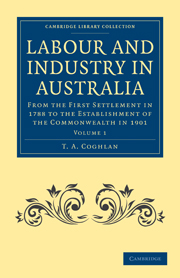 Labour and Industry in Australia
Labour and Industry in Australia Book contents
- Frontmatter
- PREFACE
- Contents
- PART I FROM THE FOUNDATION OF SETTLEMENT TO THE CROSSING OF THE MOUNTAINS
- PART II FROM THE CROSSING OF THE MOUNTAINS TO THE ABOLITION OF THE ASSIGNMENT SYSTEM
- PART III FROM THE ABOLITION OF THE ASSIGNMENT SYSTEM TO THE DISCOVERY OF GOLD
- I INTRODUCTION TO THE THIRD PERIOD
- II TRANSPORTATION
- III IMMIGRATION
- IV LAND LEGISLATION IN NEW SOUTH WALES, VAN DIEMEN'S LAND, AND WESTERN AUSTRALIA
- V LAND LEGISLATION AND SETTLEMENT IN SOUTH AUSTRALIA AND THE WAKEFIELD THEORY OF COLONIZATION
- VI LABOUR AND WAGES
- VII PRICES
- VIII FINANCIAL CRISIS OF 1841, 1842, AND 1843
- IX INDUSTRIES
- PART IV FROM THE DISCOVERY OF GOLD TO THE INTRODUCTION OF FREE SELECTION OF LAND BEFORE SURVEY
VIII - FINANCIAL CRISIS OF 1841, 1842, AND 1843
Published online by Cambridge University Press: 05 August 2011
- Frontmatter
- PREFACE
- Contents
- PART I FROM THE FOUNDATION OF SETTLEMENT TO THE CROSSING OF THE MOUNTAINS
- PART II FROM THE CROSSING OF THE MOUNTAINS TO THE ABOLITION OF THE ASSIGNMENT SYSTEM
- PART III FROM THE ABOLITION OF THE ASSIGNMENT SYSTEM TO THE DISCOVERY OF GOLD
- I INTRODUCTION TO THE THIRD PERIOD
- II TRANSPORTATION
- III IMMIGRATION
- IV LAND LEGISLATION IN NEW SOUTH WALES, VAN DIEMEN'S LAND, AND WESTERN AUSTRALIA
- V LAND LEGISLATION AND SETTLEMENT IN SOUTH AUSTRALIA AND THE WAKEFIELD THEORY OF COLONIZATION
- VI LABOUR AND WAGES
- VII PRICES
- VIII FINANCIAL CRISIS OF 1841, 1842, AND 1843
- IX INDUSTRIES
- PART IV FROM THE DISCOVERY OF GOLD TO THE INTRODUCTION OF FREE SELECTION OF LAND BEFORE SURVEY
Summary
At the beginning of the third industrial period the commerce of New South Wales was increasing very rapidly, and, tested by the usual standards applied to such cases, the colony appeared to be in a very prosperous condition. The imports of 1839 exceeded in value those of 1838 by £650,000, and, in spite of the declining price of wool, the value of exports was increased by £146,000. But to a critical observer the character of the imports must have appeared significant of danger, for they consisted to a very considerable extent of articles of personal luxury. Carriages, jewellery, and, above all, wines and spirits, bulked largely amongst the imports, the value of which vastly exceeded that of the exports, the respective figures for 1839 being, imports £2,236,371 and exports £948,776. In after years it was customary to declaim against this import as an unmixed evil, but such was not the case, as a fair proportion represented a genuine gain to the country, being new capital sent out to Port Phillip, where settlement had begun in earnest in 1839. The prospects of the new colony appeared so attractive to English capitalists that they came in large numbers and purchased extensive areas for immediate occupation. The sale of land went on vigorously, and the proceeds of the sales, both at Port Phillip and in the older settlements, poured into the Treasury at Sydney, and made immigration on a large scale possible.
- Type
- Chapter
- Information
- Labour and Industry in AustraliaFrom the First Settlement in 1788 to the Establishment of the Commonwealth in 1901, pp. 473 - 502Publisher: Cambridge University PressPrint publication year: 2011First published in: 1918
